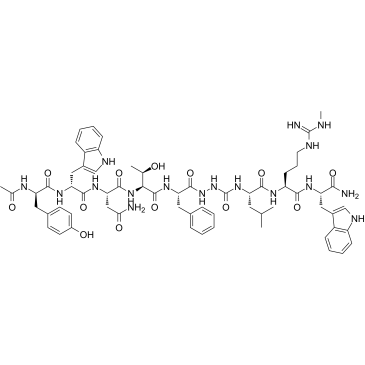TAK-683
Modify Date: 2024-03-05 13:35:55

TAK-683 structure
|
Common Name | TAK-683 | ||
|---|---|---|---|---|
| CAS Number | 872719-49-8 | Molecular Weight | 1298.45 | |
| Density | N/A | Boiling Point | N/A | |
| Molecular Formula | C64H83N17O13 | Melting Point | N/A | |
| MSDS | N/A | Flash Point | N/A | |
Use of TAK-683TAK-683 is a potent full KISS1 receptor (KISS1R) agonist (IC50=170 pM) with improved metabolic stability. TAK-683 is a nonapeptide metastin analog, exhibits agonistic activities to KISS1R with EC50 values of 0.96 nM and 1.6 nM for human and rat, respectively[1]. TAK-683 depletes GnRH in the hypothalamus and reduces plasma FSH, LH, and testosterone levels in vivo, it has the potential for the study of hormone-dependent prostate cancer[1][2][4]. |
| Name | TAK-683 |
|---|
| Description | TAK-683 is a potent full KISS1 receptor (KISS1R) agonist (IC50=170 pM) with improved metabolic stability. TAK-683 is a nonapeptide metastin analog, exhibits agonistic activities to KISS1R with EC50 values of 0.96 nM and 1.6 nM for human and rat, respectively[1]. TAK-683 depletes GnRH in the hypothalamus and reduces plasma FSH, LH, and testosterone levels in vivo, it has the potential for the study of hormone-dependent prostate cancer[1][2][4]. |
|---|---|
| Related Catalog | |
| Target |
IC50: 170 pM (metastin/GPR54)[1] |
| In Vitro | TAK-683 exhibits an IC50 value (95% CI) from receptor binding assays is 150-180 pM and EC50 value (95% CI) from Ca+ mobilization assays is 180 (159–203) pM in rat KISS1R-expressing Chinese hamster ovary (CHO) cells[4]. |
| In Vivo | TAK-683 (subcutaneous injection; 0.008, 0.08, 0.8, or 8 μmol/ml/kg; once daily; 7 days) induces an increase in plasma luteinizing hormone and testosterone levels; however, after day 7, plasma hormone levels and genital organ weights are reduced[3]. TAK-683 (subcutaneous injection; 10, 30, or 100 pmol/h; once daily; 4 weeks) provides a promising for suppressing reproductive functions and hormone-related diseases such as prostate cancer[3]. TAK-683 (subcutaneous injection; 2.1-21 nmol/kg/day; once daily; 12 weeks) has a longer-term evaluation in prostate cancer model, serum concentrations of PSA is reduced in rats, PSA concentrations are reduced to below the limit of detection (0.5 ng/ml)) in all rats by day 14[4]. Animal Model: Male SD rat with prostate cancer model[4] Dosage: 2.1, 7, 14, 21 nmol/kg/day Administration: Subcutaneous injection Result: Exhibited a sustained testosterone suppression in rat. |
| References |
[4]. Hisanori MATSUI, et al. Functional Analyses of Kisspeptin in Controlling Gonadal Functions |
| Molecular Formula | C64H83N17O13 |
|---|---|
| Molecular Weight | 1298.45 |